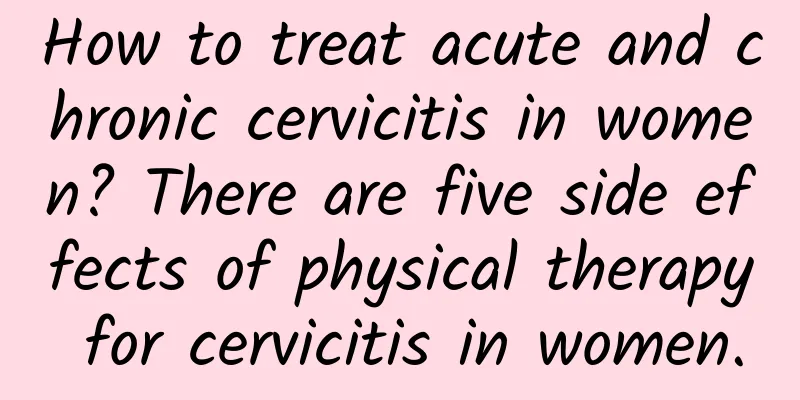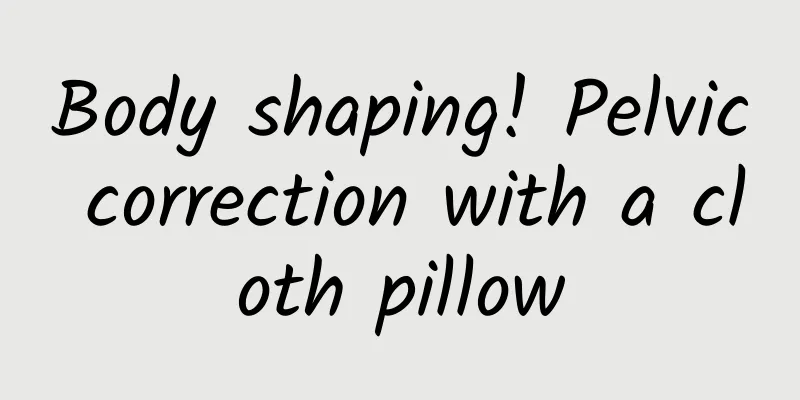How to treat acute and chronic cervicitis in women? There are five side effects of physical therapy for cervicitis in women.

|
Cervicitis has now become the most common gynecological disease for female friends, so you need to choose the appropriate treatment method according to your condition. The most common one is physical therapy. Although this treatment method is more effective, it will definitely cause side effects after using it for a period of time. However, the side effects are usually not so obvious, and most people will just feel some changes in the skin. 1. Neurological diseases Limb dysfunction caused by cerebrovascular disease, brain degenerative disease, brain trauma, spinal cord disease, spinal cord injury, peripheral nerve disease or injury, etc. 2. Diseases of the bone and muscle system Arthritis, ankylosing spondylitis, soft tissue injury, fracture, amputation, neck, shoulder, waist and leg pain, scoliosis and sports injuries, etc. 3. Cardiopulmonary dysfunction Before and after thoracic, abdominal and cardiac surgery, chronic obstructive respiratory disease, pleurisy, pneumonia and bronchiectasis, etc. 4. Diseases of the digestive system and urogenital system. 5. Skin tissue physical therapy, etc. 1. Acute cervicitis The main treatment is antibiotics. (1) Empirical antibiotic treatment For patients with the following high-risk factors for sexually transmitted diseases (such as age under 25 years, multiple or new sexual partners, and unprotected sexual intercourse), empirical antibiotic treatment against Chlamydia is used before the results of pathogen testing are obtained. (2) Antibiotic treatment targeting pathogens For those who have acquired pathogens, antibiotics targeting pathogens are selected. Since Neisseria gonorrhoeae infection is often accompanied by chlamydia infection, if it is gonococcal cervicitis, in addition to the use of anti-Neisseria gonorrhoeae drugs, anti-chlamydia infection drugs should also be used during treatment. (3) Treatment of sexual partners: If the pathogens of cervicitis patients are Chlamydia trachomatis and Neisseria gonorrhoeae, their sexual partners should be examined and treated accordingly. Different treatments are used for different lesions. For those who present with erosive changes, if it is asymptomatic physiological columnar epithelial ectopy, no treatment is required. For erosive changes accompanied by increased secretions, papillary hyperplasia or contact bleeding, local physical therapy can be given, including laser, freezing, microwave and other methods. Traditional Chinese medicine treatment or its use as an adjuvant treatment before and after physical therapy can also be given. However, cervical intraepithelial neoplasia and cervical cancer must be screened out before treatment. 2. Chronic cervicitis (1) Chronic endocervical mucositis For persistent endocervical mucosal inflammation, it is necessary to check whether there is reinfection with Chlamydia trachomatis and Neisseria gonorrhoeae, whether the sexual partner has been treated, and whether the vaginal microbiome imbalance persists. Treatment should be given according to the cause. For those whose pathogens are unclear and there is no effective treatment, physical therapy can be tried. (2) Cervical polyps are treated with polypectomy, and the removed polyps are sent for pathological histological examination. (3) Cervical hypertrophy generally does not require treatment. |
Recommend
Late menopause may be a symptom of ovarian cancer
Ovarian cancer has now become one of the biggest ...
Eliminate edema and enjoy slim and beautiful legs with traditional Chinese medicine in 3 steps
Stress-induced obesity and edema make you fat, es...
Why do I still have uterine fibroids if my endometrium is thin? What should I do if my endometrium is thin and I still have uterine fibroids?
Why do I still have uterine fibroids when my endo...
What should women pay attention to in their diet after abortion? Four points to pay attention to in women's diet after abortion
After abortion, women are weak and should pay att...
Experts briefly analyze the common symptoms of chronic cervicitis
The symptoms of chronic cervicitis are a matter o...
What causes cervicitis in women? Be alert to the four major causes of cervicitis in women
Many women do not fully understand the causes and...
Is it normal for leucorrhea to be brown? Should it be treated?
What is wrong with leucorrhea that is mostly brow...
How to treat yellow leucorrhea after artificial abortion? 4 methods to treat yellow leucorrhea
Yellow leucorrhea after abortion is likely caused...
Why do women's private parts have "spasms"? Don't panic, understand these 5 common problems first
In the clinic, I met a girl named Xiaomei. She sh...
What examinations are needed for habitual miscarriage?
Habitual miscarriage has many harmful effects and...
Can I eat longan after abortion?
You can eat longan in moderation after abortion, ...
The specific symptoms of acute adnexitis are as follows:
Many women want to know how to prevent acute adne...
What harm does uterine fluid cause?
The uterus is a product of cervical inflammatory ...
Anterior pelvic tilt is not fat! Learn how to lose belly fat from muscle-building moms
After getting pregnant and giving birth, some mot...
How to prevent pelvic inflammatory disease
Pelvic inflammatory disease is an inflammation of...









